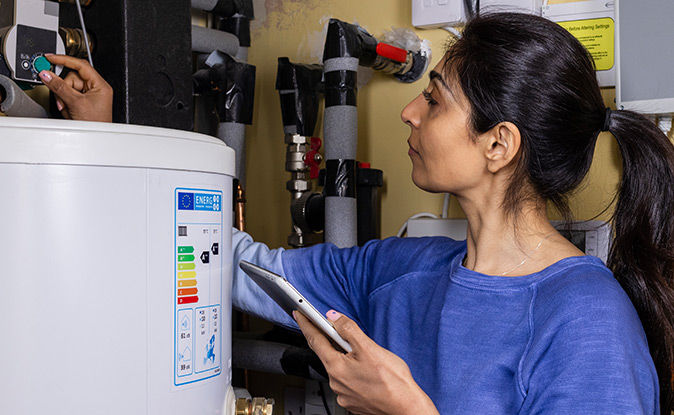Demand Response
Simple changes add up to energy savings.
Lower Your Energy Costs. Ease Stress on the Grid During High Demand.
By participating in Demand Response, you can save on your electric bill and help improve grid reliability in times of high energy demand, like during a heat wave. Demand Response programs also contribute to our goal of helping Michigan become a cleaner, better place for future generations.
- Manage your energy use in peak demand times to take advantage of incentives and save on your electric bill.
- Rely on automated solutions during Demand Response Events, which may include adjusting your home thermostat temperature or cycling an air conditioner.
Demand Response Gives You Options


What Is a Demand Response Event?
A Demand Response Event is a period of high energy demand when we activate programs to relieve stress on the grid.
As a Demand Response participant, you're encouraged or assisted to reduce your electricity usage during an event. That may include adjusting the use of your washer, dryer or dishwasher to times outside an event. Some Demand Response options also help you reduce your electricity usage automatically by slightly adjusting your thermostat, pausing your electric vehicle’s charge or cycling your air conditioning unit.
What Happens During a Demand Response Event?

Demand Response Solutions
With Demand Response, you can take more control of your energy bill, be aware of your household energy usage and make adjustments to your daily habits to help conserve energy and lower your costs.
You may be eligible for Demand Response if you’re a DTE electric customer willing to participate in Demand Response Events and have a smart meter (also called an AMI meter). Learn more about smart meters.
Please review and compare your Demand Response options for specific details and to find the one that works best for your lifestyle.
Efficient Ways to Save
Flexibility and planning are keys to saving money in Demand Response. You can reduce your electricity costs and strain on the grid by shifting or reducing some of your energy use to off-peak weekday hours or all weekend – especially on days when Demand Response events are called.

Do Laundry on Weekends
With off-peak hours all day Saturdays and Sundays, the weekend is a great time to catch up on laundry.
Tips: Use cold or cool water settings for washing. Heating water accounts for up to 90% of the energy used in each washload. And fill — but don’t overfill — your dryer for each load. Smaller loads use the same amount of energy as larger ones.

Set a Thermostat Schedule
You can reduce heating and cooling costs by setting a schedule on your smart thermostat during your on-peak rate hours. Refer to your DTE bill for additional details regarding your rate.
Tips:
- During winter months, the ideal range to program your thermostat is between 68 and 70 when you’re home. Use smart features to lower the temperature to 65 when you’re asleep or away.
- In the summer, pre-cool your home prior to a Demand Response event by setting your thermostat 2-3 degrees lower than normal.

Run Your Dishwasher During Off-Peak Hours
A great way to save money and energy is to run your dishwasher before or after an event or during your off-peak rate hours. Refer to your DTE bill for additional details regarding your rate.
Tips: Many dishwashers now have a delay setting. Load the machine after dinner and set it to run overnight to take advantage of off-peak pricing.

Save with Smart Strips & Plugs
Many electronic devices continue to draw energy even when not in use. Installing a smart power strip can help you manage energy use by better regulating these devices.
Tips: A smart plug controlled by a smartphone app lets you power off lamps, TVs, printers and gaming consoles when they aren’t being used.
Frequently Asked Questions
Demand Response is significant to the operation and sustainability of the electric grid and expanding grid modernization. For DTE, Demand Response addresses two primary goals:
- To provide our customers with more ways to lower their energy costs
- To help reduce stress on the electric grid during periods of high demand
Demand Response can also help achieve the Company’s goal of Net Zero Emissions by 2050.
Less energy consumption during Demand Response Events provides benefits for everyone. By reducing the need for additional generation during these periods, the cost of energy is kept lower for all customers.
Demand Response programs are being offered across the U.S. and internationally. They provide customers like you the opportunity to participate in managing and balancing the electric grid. You can do your part by reducing or shifting your electricity usage during peak periods.
By participating in Demand Response programs you can save money by reducing electricity use during periods of high demand or by shifting some of your energy use to take advantage of time-based rates.
Choose what works best for you from among six Demand Response options, including automated solutions to manage your energy use.
A Demand Response Event may vary from a slight adjustment to your thermostat to other automated adjustments, like cycling your cooling system, depending on which option you choose. You may not even notice a significant change from these adjustments.
Some Demand Response incentives encourage you to take more control of your electric bill. For instance, if you're able to be flexible about when you do your laundry or run your dishwasher, you can take advantage of incentives based on off-peak hours in the early morning, late evening and weekends.
Although we have enough generation for our own customers, Demand Response Events can occur when demand for electricity is predicted to or does exceed available generation in other areas connected to the same electric system as DTE through the Midcontinent Independent System Operator (MISO). For example, an extreme heat wave in a surrounding state that causes a spike in electric consumption can trigger a Demand Response Event in Michigan, since 15 states in the Midwest and the South are connected to the same grid.
Contact Us
For more information, please call us toll free, (833) 627-2300 from 8 a.m. to 7 p.m. Monday through Friday (excluding holidays).
For questions specific to DTE Smart Charge, please email us at smartcharge@dteenergy.com.
Demand Response
Simple changes add up to energy savings.
Find an Option That Works for You
Review and compare your Demand Response options below to find the one that works best for you. Each option includes a link to more details, benefits, requirements and information on how to enroll or switch to your preferred choice.

Smart Savers
Perfect for residential electric customers who already have a smart, Wi-Fi-enabled thermostat installed.
Events: During Smart Savers events, all participating thermostats will be automatically adjusted up to four degrees from the thermostat’s original setpoint. Adjustments typically last no more than four hours between 12 p.m. and 8 p.m. on weekdays and non-holidays from June 1 through September 30.
- Provides a simple way to save that requires no effort on your part during scheduled Smart Savers events.
- You are rewarded for participating in Smart Savers events during periods of high electric demand.
- You'll receive a $50 bill credit each year you participate in events.
“Frequency of communication is good, not too much, and its direct and helpful.”
– Simon C., Participant since 2022
“Saves you money by lowering usage when it is not needed, and you don’t have to think about it.”
– Steve S., Participant since 2022
“It was easy to participate in the program and the program worked smoothly without any discomfort to us.”
– Wendy K., Participant since 2018
“Good communication and helping others understand how easy it is to be impactful in saving energy and money!”
– Kathleen M., Participant since 2019
- Testimonial 1
- Testimonial 2
- Testimonial 3
- Testimonial 4

CoolCurrents®
Ideal for residential electric customers with central air conditioning or a whole-home air source heat pump who can install an additional smart meter and a 24-volt power source connection.
Events: During events, we’ll briefly cycle your air conditioning or air source heat pump in 15-minute intervals by sending a signal to the device. The cycling of your equipment will be limited to no more than eight hours in a 24-hour period and no more than 30 minutes per hour.
Includes a discounted Interruptible Space Conditioning rate designed to help you save when compared to the Time of Day 3 p.m. – 7 p.m. rate:
- Save up to 30% on the cooling portion of your energy bill throughout June and September during peak hours.
- Customers with a whole-home air source heat pump save up to 26% on the electric heating portion of their energy bill during peak hours.

Water Heating Service
Great for your household budget if you can allow temporary interruptions of electricity to your water heater and have a separately metered circuit for water heating.
Events: There may be temporary interruptions of electricity to your water heater for up to four hours per day.
- Provides a lower rate for electric water heater usage.

DTE Smart Charge
Ideal for electric vehicle (EV) drivers that would like their EV’s home charging to occur during off-peak time periods, based the time of use electric rate schedule they’re on.
Overview: DTE Smart Charge helps EV drivers manage their charging during times of the day that help the energy grid operate more efficiently. DTE Smart Charge will schedule daily charging to meet your charging needs and will occasionally shift charging to help optimize the energy grid.
- You’ll always have control of your participation and can opt out of an event at any time.
- You receive up to $100 in gift cards for enrollment and participation.
Explore Other Electric Pricing Options
DTE offers three additional tiered pricing options that are separate from Demand Response. Learn more about:
- Time-of-Day option from 3 p.m. to 7 p.m.
- Time-of-Day option from 11 a.m. to 7 p.m.
- Overnight Savers option from 1 a.m. to 7 a.m.
Please visit Electric Pricing Options to review all your electric pricing alternatives, add-ons and incentives.
Contact Us
For more information, please call us toll free, (833) 627-2300 from 8 a.m. to 7 p.m. Monday through Friday (excluding holidays).
For questions specific to DTE Smart Charge, please email us at smartcharge@dteenergy.com.


